Something a little different this time. I got e-mail from an artist asking me to check out his show, so I wrote back and we ended up arranging a meeting where he could tour me through his paintings and we could talk extensively about them. And that's what we did.
I'm not sure why Denis Peterson wrote to me. Maybe it's because I mentioned in passing once that I used to airbrush. Maybe it's because of my frequent use of the term photorealism. I'm not sure and I forgot to ask. But I'm glad he did.
First, I must confess: I use the term photorealism a lot, but I'm actually not that deeply familiar with it. If you asked me to name a photorealist, for example, I wouldn't have been able to (I can now, because I did some research on it). But I'm roughly familiar with the basic idea of photorealism and where it falls in the art timeline, so I can toss the term around and sound like I almost know what I'm talking about.
Despite my ignorance, I've had something of an affinity for the concept of photorealism for a long time, because -- as I hinted in an earlier post -- I took a long detour into being an airbrush artist. I had my Paasche and my compressor. I spent a summer airbrushing t-shirts on the boardwalk in Wildwood, New Jersey. I wasted many hours of my life poring over issues of Airbrush Action and books on the work of Vargas, Olivia, Giger, and Sorayama (to say nothing of Big Daddy Roth and Robert Williams). I put my time in cutting friskets and cleaning machinery. I used to blow my nose and get a rainbow of gouache. I shudder to think of all the formaldehyde I inhaled. It wasn't until I had worked my way up to an Iwata and started having massive air quality problems that I finally got so fed up with airbrushing I quit. Blues One Two Three has my last touch of airbrush: I sprayed the underpainting of the saxophone, then did the rest by hand in gouache. After that I switched over to oils and never looked back.
To this day, though, I maintain an appreciation for airbrush. I do love it. As a tool it seems to be dying out; airbrush was always more of a commercial art tool, and it's been mostly replaced by Adobe Photoshop and digital tablets. But airbrush still holds a special place in my heart because I know how hard it is to be good at it.
So when Denis contacted me there was no way I could say no. After all, here's an artist who's been using airbrushes almost as long as I've been alive, and look at the work on his Website: Could you tell they aren't photos?
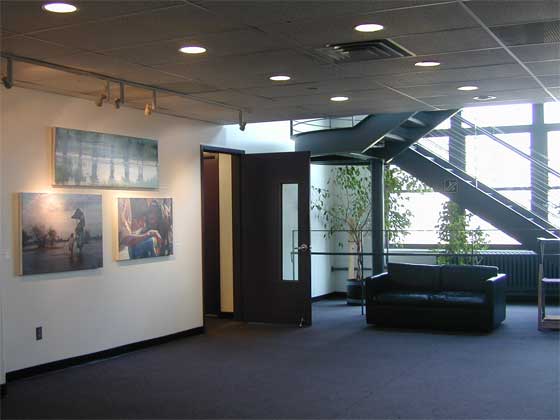 I arrived at the Metropolitan College of New York's Next Gallery twenty minutes early so I could have a look at Don't Shed No Tears before meeting with Denis. I was surprised to find that the Next Gallery is a gallery in the old sense of the word, which is to say a hallway. It's just a section of the offices of MCNY with students and administrators passing back and forth and paying nowhere near enough attention to the art on the walls.
I arrived at the Metropolitan College of New York's Next Gallery twenty minutes early so I could have a look at Don't Shed No Tears before meeting with Denis. I was surprised to find that the Next Gallery is a gallery in the old sense of the word, which is to say a hallway. It's just a section of the offices of MCNY with students and administrators passing back and forth and paying nowhere near enough attention to the art on the walls.
And the art on the walls: I was immediately overwhelmed by questions ranging from the highest and most abstract down to the smallest and most detailed. These paintings are truly marvelous examples of craft: If I didn't know they were paintings, I would have thought they were color photos inkjet printed onto canvas. From a viewing distance each one is indistinguishable from a photo; up close, the fidelity is astonishing. Each painting has that quality that lower quality digital video can have, where lines resolve into slightly off-register multiple colors, deep colors are flattened, and the dynamic range of saturated colors is clipped.
So many of the questions swirling through my head were practical questions on technique: How were these made? What kind of photos are they based on? What model of airbush was used? What kind of paint? What artistic process was followed? What choices were made?
At the same time, the content of the paintings is overwhelming. Each painting depicts a person or people (or, in a few cases, a neighborhood) suffering. It's not always apparent from the image itself, but the context of the images makes it clear: These paintings are about genocide, death, displacement, pain, survival.
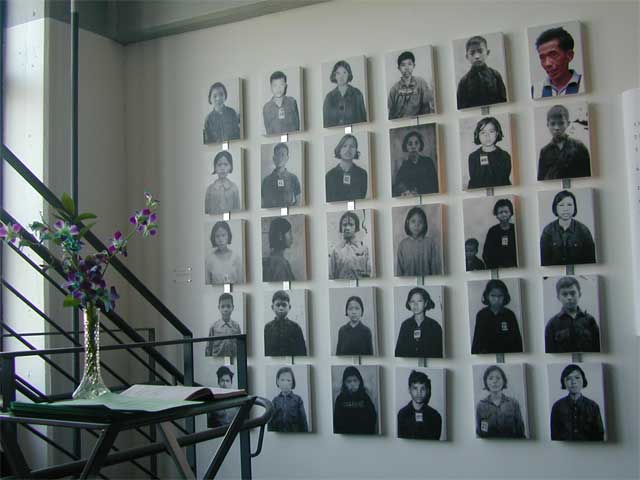 I was most drawn to an arrangement of paintings set up like a photo array. Asians look out at us from poorly developed monochrome photos like mug shots, each wearing a badge with a number pinned to their chest. One woman holds a baby. One woman holds a small child by the hand. There's no defiance, no shows of strength; there's no despair, either, no evidence of hopelessness. There's just the air of an institution, albeit one in great disrepair. Except one color image shows a grinning man in a casual shirt.
I was most drawn to an arrangement of paintings set up like a photo array. Asians look out at us from poorly developed monochrome photos like mug shots, each wearing a badge with a number pinned to their chest. One woman holds a baby. One woman holds a small child by the hand. There's no defiance, no shows of strength; there's no despair, either, no evidence of hopelessness. There's just the air of an institution, albeit one in great disrepair. Except one color image shows a grinning man in a casual shirt.
We've seen enough evidence of holocausts past to know what this is: These are photos of victims. The explanatory text on the wall beside the image explains but does not explain. These people were Cambodians, imprisoned, tortured, and then murdered, all on the orders of the grinning man.
Viewing these images, any rational being asks why. Why do people do these things? What's the full story behind each of these paintings? And why would someone paint them?
It wasn't long before Denis Peterson arrived and I could ask him some of the many questions I had. We spoke for a couple of hours, and as you'd expect, the bigger questions were never really answered, and the smaller ones, well, they didn't seem as important.
I had expected Denis to be some kind of intense, crazed artist, the kind of person who would pursue a quixotic medium like airbrush and then tackle a huge and difficult subject like genocide. What he turned out to be was a quintessential New Yorker, the kind of man on the street you might ask for directions; he has an air of easy intelligence and the assured physical presence of a craftsman. When he spoke it wasn't with the air of a prophet or madman. In fact he seemed as surprised as anyone that his work turned out the way it did.
It is certainly true that Denis' career in art has taken some turns. Over the course of his conversation I pieced together a rough sketch of his art life. His grandfather was an artist and art restorer who taught him about art, drawing, and painting. His father, on the other hand, steered Denis away from a career as an artist. It didn't work out, though: He went to school for his BFA and MFA, then went into commercial illustration. For years he maintained an art studio on the side, but as his family and his responsibilites grew -- he has six children, two of whom called on his cell while we were talking -- he shut it down. In fact he moved all of his studio -- furniture, easels, paintings, paints -- out onto the lawn in Brooklyn and put up a sign reading, "FREE". And you know how artists are when anything is free; his entire studio was gone in no time.
Now here he is, twenty years later, returning to fine art. He started painting again and doing different things, approaching different subjects. He did a number of large oil paintings in a more classical style, figurative works, sort of portraits. He had enough for an exhibition, in fact, when he started talking to people about putting something up at MCNY.
But as he was planning some kind of exhibit, he thought, "You know, everyone's seen paintings like these. I want to show people something they haven't seen, something really interesting." So Denis began looking for more exotic and interesting subjects. As he did so, he found himself drawn to photojournalism and work from the dangerous places in the world. He began to read more about these places, far away from New York City, where terrible things happen. In spite of himself he began to look, and looking, he couldn't stop. He started writing to journalists and institutions for material; he was surprised to find how interested they were in his work and how much they were willing to support him. They sent him more photos than he could ever use. Pretty soon he was creating the paintings in this show.
Perhaps some of the compulsion comes from Denis' past: His great-grandmother came to America fleeing the inaugural genocide of the 20th century when the Ottoman Turks systematically murdered 1.5 million Armenians. As Denis pointed out, when Hitler was planning his campaign, he asked, "Who, after all, speaks today of the annihilation of the Armenians?"
Of course today information about such things is easy to come by. The Armenian Genocide has a Website. So this leaves the question of what Denis hopes to accomplish with these paintings. I don't think he knows for sure. He's found a subject which interests him; no, interests is the wrong term. He's not interested. Even he asks: "Why would anyone want to look at this stuff? It's ugly, it's horrible." He seems tired of it, weary of being involved. But he also feels he has to do something, however small. When he started, his hope was that, if a painting sold, he could somehow get some of the money from it to whoever is in it. Now, I think he's happy that people are learning from his work, seeing something they haven't seen before.
It's difficult work. I know from my experience -- I don't think all artists are like this, but it's certainly true for me -- when I paint a person, I fall in love with them. Even if it's a person I've created, just an image on a canvas from my imagination, some part of me falls in love with them while I'm painting them. I can only imagine the emotions involved in painting someone you know has suffered, been tortured, who may be dead, someone you can never know.
So Denis' work is really in spite of his own desires: He'd rather be painting horses at Belmont, or doing sunsets or something. But what he's accomplished is different, more difficult, more powerful, more painful. It may not be something he'd choose for himself, but he's done it anyway.
As to how he does it, well, that's an easier thing to discuss. Denis starts from digital photos. From these he makes changes: He crops them differently, considers different color schemes, removes people, alters compositions. Then he uses an Iwata airbrush through which he pushes various acrylic paints, often using thinned housepaint. He doesn't use paints formulated specifically for airbrush; when he started out in the early 1970s they didn't exist, and he hasn't switched. Denis has an extraordinarily steady hand. There's a story of Leonardo da Vinci drawing a perfect circle at arm's length. I don't know if Denis can draw a perfect circle but he tells me he can freehand a perfectly straight line.
He builds up what he considers thick layers of paint as he goes, getting effects from different levels of transparency. He also goes back in with colored pencils and paintbrush. If you look very closely you can see pencil marks here and there. The effect is miniscule but it all adds up.
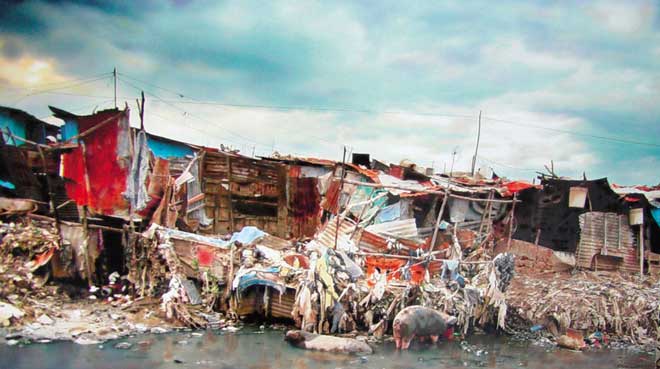
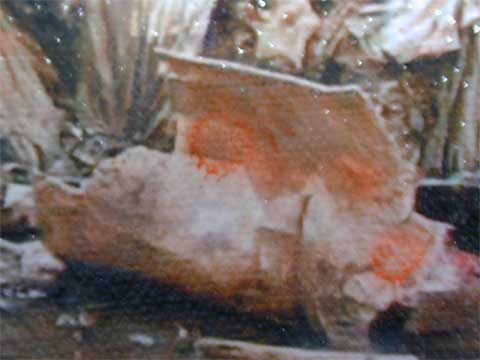 At first glance his paintings seem marvels of precision and in many ways they are. But some of his effects are developed through surprisingly messy work: In one painting there's an almost perfect looking smashed plastic bucket, but if you look very closely you can see a big spray of paint right in the middle of it. You wouldn't think this would work but it does.
At first glance his paintings seem marvels of precision and in many ways they are. But some of his effects are developed through surprisingly messy work: In one painting there's an almost perfect looking smashed plastic bucket, but if you look very closely you can see a big spray of paint right in the middle of it. You wouldn't think this would work but it does.
Denis told me about a curious technique he learned from his grandfather. Each line you see, he said, is actually three lines. He had some trouble explaining exactly how that worked, but the gist of it is where you think there's only one line, there's actually the end of one material, the beginning of the next, and the edge between them. He applies this to his paintings and it gives his work an interesting shimmer: The lines don't always match up flawlessly and that accounts for the off-register digital video coloration.
 Of course it may also be fidelity to his source materials. The photos Denis works from are sometimes heavily compressed and full of digital artifacts, and Denis, when he likes the effect, faithfully reproduces them. It's actually quite amazing. I've worked with digital image formats for years and have a very good eye for picking up certain features, so when I looked at Denis' Journey of a Thousand Nights, I was astonished to see what was clearly JPEG compression artifacts in the background grass. I wouldn't have believed anyone could reproduce them by hand, but Denis has.
Of course it may also be fidelity to his source materials. The photos Denis works from are sometimes heavily compressed and full of digital artifacts, and Denis, when he likes the effect, faithfully reproduces them. It's actually quite amazing. I've worked with digital image formats for years and have a very good eye for picking up certain features, so when I looked at Denis' Journey of a Thousand Nights, I was astonished to see what was clearly JPEG compression artifacts in the background grass. I wouldn't have believed anyone could reproduce them by hand, but Denis has.
As I mentioned earlier, though, Denis doesn't just reproduce photos. In fact one of my biggest questions was, "Why paint a painting which could be a photo?" Denis' answer involved some handwaving, but in the end it all comes down to the basic premise of art: That an image filtered through the mind of an artist has a value over a mechanical reproduction. The photos from which he works, Denis says, are just part of what he uses to create his paintings. Many details are added by his imagination; elements are emphasized, some are removed entirely. In Waterfront, the original photo had families posing in the foreground; Denis didn't put them in his painting. He's very conscious of the art involved in composing his images. He's very thoughtful regarding things like facial detail -- "I left these undefined because I wanted them to be timeless, like this scene is endless, just an endless line of women bringing firewood" -- and balance -- "I added this necklace because I wanted something detailed over on this side of the painting".
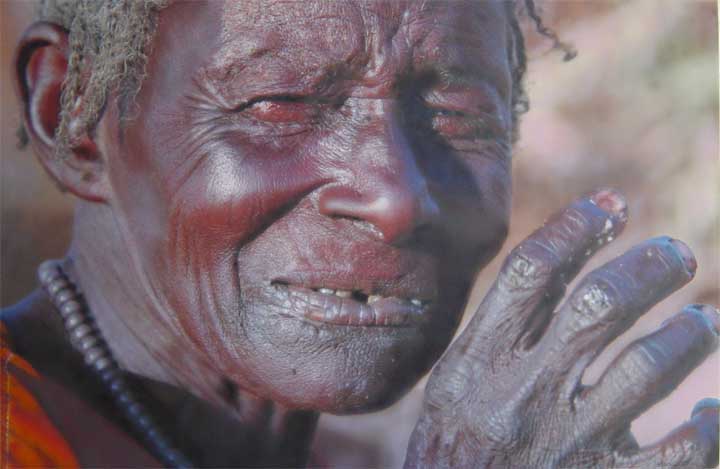 Denis taught me a little about photorealism, too. The photorealists, he told me, only painted as much detail as was needed to get the idea across. They sought the absolute least amount of fine detail which would make a viewer think they were seeing a photo -- and no more. Denis calls his style hyperrealism because he adds more detail than any photo would ever show. In Don't Shed No Tears, for example, he was painting the wrinkles under the woman's eye as he saw them in the photo. And then he added some, thinking, if these are here, why not these?
Denis taught me a little about photorealism, too. The photorealists, he told me, only painted as much detail as was needed to get the idea across. They sought the absolute least amount of fine detail which would make a viewer think they were seeing a photo -- and no more. Denis calls his style hyperrealism because he adds more detail than any photo would ever show. In Don't Shed No Tears, for example, he was painting the wrinkles under the woman's eye as he saw them in the photo. And then he added some, thinking, if these are here, why not these?
In sum, then, these paintings might appear to be photos, but they depart significantly from being mere reproductions of photos. And I think, too, there's a feeling from them best described in a lyric from Don McLean's song "Vincent": "Weathered faces lined in pain/Are soothed beneath the artist's loving hand". When Denis paints the portraits of twenty-nine Cambodian prisoners, he tries to paint them the way they might want to have been seen. These are people to him, not just masses of color to be blocked in.
There's not much more to say that the paintings don't say themselves. They are extraordinary paintings from an extraordinary artist.
Denis doesn't want to be known as the Genocide Painter. Who would? He's afraid of being pigeonholed: He can't take much more of this topic, he told me. But I have to wonder, how do you step away from something like this? How do you go back to painting horses at Belmont? Denis might say, with relief. Maybe. Maybe the subject's not important. Maybe an artist can make important art out of commonplace things.
But then maybe we need people to look at the bigger things, the darker things, the difficult things. Maybe we need people who can look on these things with compassion, with love, with care; people who can bring back something of beauty from the places where life is at its ugliest. Maybe we need people who can remind us what being human is all about, its best and its worst.
Denis Peterson may not want to be one of those people. But then he may not have a choice.


I still love my Iwata 505 - it's the Porsche of grav feeds and the nozzle and pressure adjustor - never bettered.I actually went the other way - gave up oils as a result of my years as a commercial artist forced to used acrylics (on rapid order jobs like backdrops and scenery for TV and Film.)After a while I just wanted the same speed of attack from my own, fine art. But I'd never confine myself to just spraying or airbrushing - It does blends well, but that's about it.